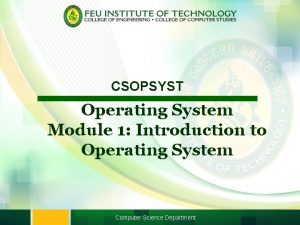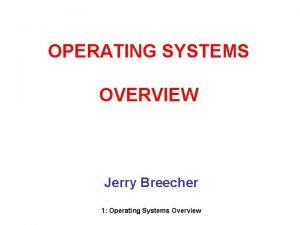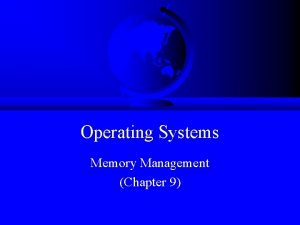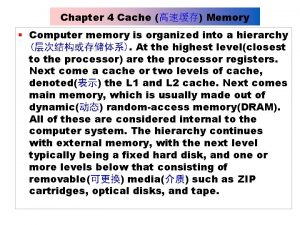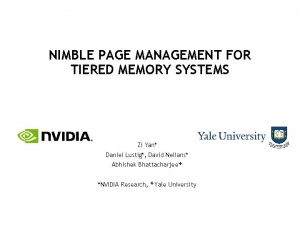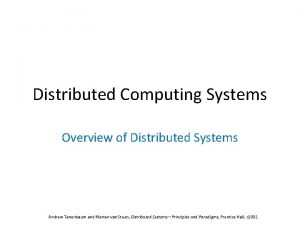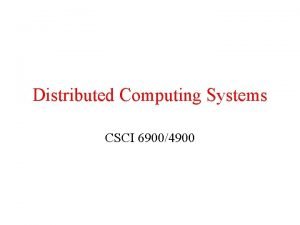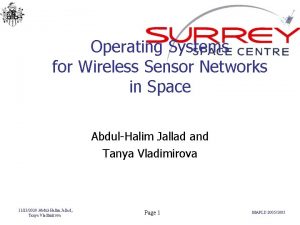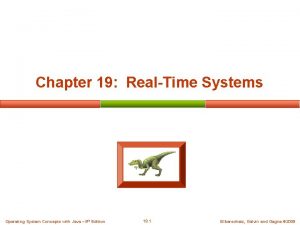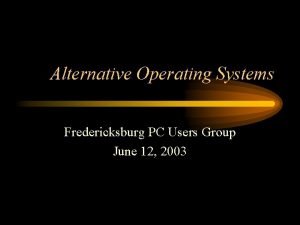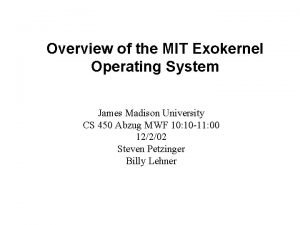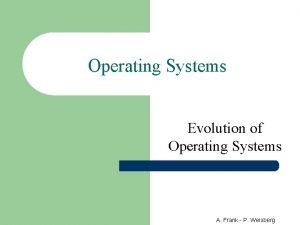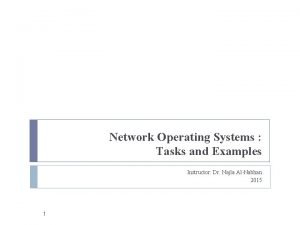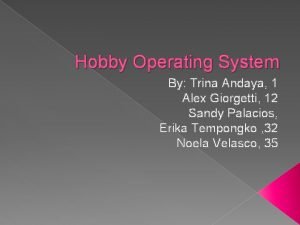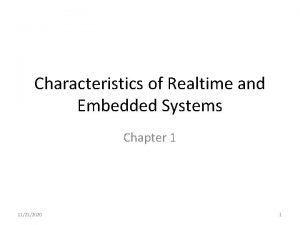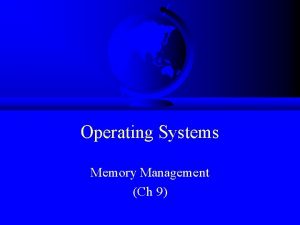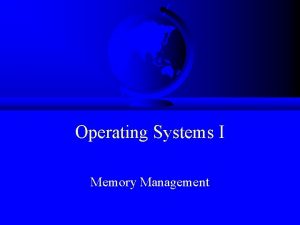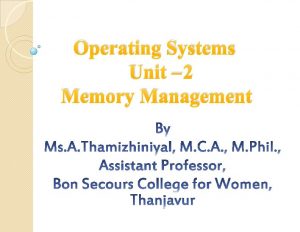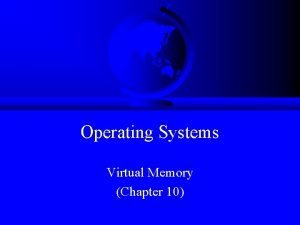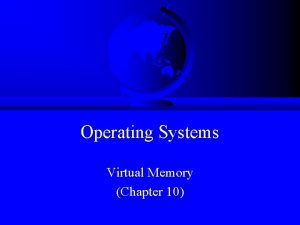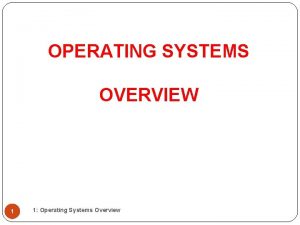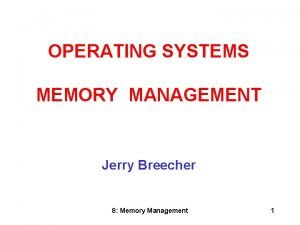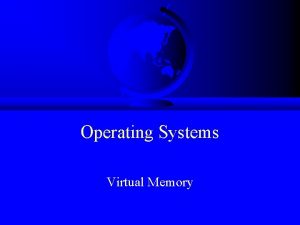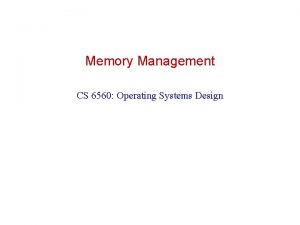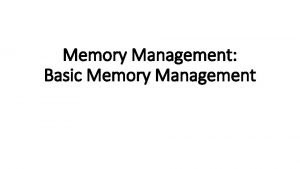Operating Systems Memory Management Chapter 9 Overview Provide
















































- Slides: 48

Operating Systems Memory Management (Chapter 9)

Overview • Provide Services – processes – files • (done) (after memory management) Manage Devices – processor – memory – disk (done) (next!) (done after files)

Simple Memory Management • One process in memory, using it all – each program needs I/O drivers – until 1960 I/O drivers RAM User Prog

Simple Memory Management • Small, protected OS, drivers – DOS OS ROM RAM User Prog OS RAM User Prog Device Drivers ROM User RAM Prog OS • “Mono-programming” -- No multiprocessing! - Early efforts used “Swapping”, but slooooow

Multiprocessing w/Fixed Partitions Simple! Partition 4 900 k Partition 3 Partition 4 Partition 3 500 k Partition 2 Partition 1 OS Partition 2 300 k 200 k (a) • Unequal queues Partition 1 OS (b) • Waste large partition • Skip small jobs Hey, processes can be in different memory locations!

Address Binding • Compile Time Source – maybe absolute binding (. com) • Link Time – dynamic or static libraries • Object Load Time – relocatable code • Compile Run Time – relocatable memory segments – overlays – paging Link Load Module Load RAM Binary Run

Normal Linking and Loading Printf. c Main. c gcc Printf. o ar Static Library Main. o Linker a. out Loader Memory X Window code: - 500 K minimum - 450 K libraries

Load Time Dynamic Linking Printf. c Main. c gcc Printf. o ar Dynamic Library Main. o Linker a. out Loader Memory • Save disk space. • Libraries move? • Moving code? • Library versions? • Load time still the same.

Run-Time Dynamic Linking Printf. c Main. c gcc Printf. o ar Dynamic Library Run-time Loader Main. o Linker a. out Loader Memory Save disk space. Startup fast. Might not need all.

Memory Linking Performance Comparisons

Design Technique: Static vs. Dynamic • Static solutions – compute ahead of time – for predictable situations • Dynamic solutions – compute when needed – for unpredictable situations • Some situations use dynamic because static too restrictive (malloc) • ex: memory allocation, type checking

Logical vs. Physical Addresses • • Compile-Time + Load Time addresses same Run time addresses different CPU Logical Address 346 Relocation Register 14000 Physical Address 14346 + MMU • User goes from 0 to max • Physical goes from R+0 to R+max Memory

Relocatable Code Basics • • Allow logical addresses Protect other processes Limit Reg CPU yes < no Memory Reloc Reg + MMU error • Addresses must be contiguous! physical address

Variable-Sized Partitions • • Idea: want to remove “wasted” memory that is not needed in each partition Definition: – Hole - a block of available memory – scattered throughout physical memory • New process allocated memory from hole large enough to fit it

Variable-Sized Partitions OS process 5 process 8 OS process 5 8 done 9 arrv OS process 5 OS process 9 process 10 5 done process 2 • process 2 OS keeps track of: – allocated partitions – free partitions (holes) – queues! 10 arrv process 2

Memory Request? • What if a request for additional memory? OS process 3 process 8 process 2 malloc(20 k)?

Internal Fragmentation • Have some “empty” space for each processes A stack Room for growth Allocated to A A data A program OS • Internal Fragmentation - allocated memory may be slightly larger than requested memory and not being used.

External Fragmentation • External Fragmentation - total memory space exists to satisfy request but it is not contiguous OS 50 k 125 k Process 9 ? process 3 process 8 100 k process 2 “But, how much does this matter? ”

Analysis of External Fragmentation • Assume: – system at equilibrium – process in middle – if N processes, 1/2 time process, 1/2 hole + ==> 1/2 N holes! – Fifty-percent rule – Fundamental: + + adjacent holes combined adjacent processes not combined

• • • Compaction Shuffle memory contents to place all free memory together in one large block Only if relocation dynamic! Same I/O DMA problem (a) (b) OS 125 k Process 9 OS OS 50 k process 3 90 k process 8 60 k process 8 100 k process 3 process 2

Cost of Compaction process 1 50 k process 1 process 3 90 k process 8 60 k process 2 100 k process 2 • 128 MB RAM, 100 nsec/access • 1. 5 seconds to compact! Disk much slower!

Solution? • Want to minimize external fragmentation – Large Blocks – But internal fragmentation! • Tradeoff – Sacrifice some internal fragmentation for reduced external fragmentation – Paging

Where Are We? • Memory Management – fixed partitions – linking and loading – variable partitions • • Paging Misc (done)

Paging • Logical address space noncontiguous; process gets memory wherever available – Divide physical memory into fixed-size blocks + + size is a power of 2, between 512 and 8192 bytes called Frames – Divide logical memory into bocks of same size + called Pages

Paging • Address generated by CPU divided into: – Page number (p) - index to page table + page table contains base address of each page in physical memory (frame) – Page offset (d) - offset into page/frame CPU p d f page table physical memory

Paging Example • • Page size 4 bytes Memory size 32 bytes (8 pages) 0 1 Page 0 2 Page 0 0 1 Page 1 1 4 Page 2 2 3 Page 3 3 7 Logical Memory Page Table 3 Page 2 4 Page 1 5 6 7 Page 3 Physical Memory

Paging Example Offset Page 0 Page 1 010 011 00 01 011 Page 2 100 01 11 100 101 10 00 101 Page 3 000 110 110 001 0 Page 111 Logical Memory 0 1 0 Frame Page Table 1 1 001 010 111 Physical Memory

Paging Hardware • • • address space 2 m page offset 2 n page number 2 m-n page number p m-n phsical memory 2 m bytes page offset d n • note: not losing any bytes!

Paging Example • • • Consider: – Physical memory = 128 bytes – Physical address space = 8 frames How many bits in an address? How many bits for page number? How many bits for page offset? Can a logical address space have only 2 pages? How big would the page table be?

Another Paging Example • • • Consider: – 8 bits in an address – 3 bits for the frame/page number How many bytes (words) of physical memory? How many frames are there? How many bytes is a page? How many bits for page offset? If a process’ page table is 12 bits, how many logical pages does it have?

Page Table Example Page 0 0 3 Page 1 1 7 Process B m-n=3 Page 0 Page 1 Process A 0 1 Page Table page number p b=7 page offset d n=4 0 1 1 4 Page Table Page 0 A 2 3 Page 0 B 4 Page 1 A 5 6 7 Page 1 B Physical Memory

Paging Tradeoffs • • Advantages – no external fragmentation (no compaction) – relocation (now pages, before were processes) Disadvantages – internal fragmentation + consider: 2048 byte pages, 72, 766 byte proc – 35 pages + 1086 bytes = 962 bytes + + avg: 1/2 page per process small pages! – overhead + + page table / process (context switch + space) lookup (especially if page to disk)

Implementation of Page Table • • Page table kept in registers Fast! Only good when number of frames is small Expensive! Registers Memory Disk

Implementation of Page Table • • Page table kept in main memory Page Table Base Register (PTBR) Page 0 0 1 Page 1 1 4 Logical Memory • • PTBR Page Table 0 1 4 1 Page 1 2 Page 0 3 Physical Memory Page Table Length Two memory accesses per data/inst access. – Solution? Associative Registers

Associative Registers logical address CPU 10 -20% mem time p d page frame number hit f d physical address associative registers miss (Intel P 3 has 32 entries) (Intel P 4 has 128 entries) f page table physical memory

Associative Register Performance • Hit Ratio - percentage of times that a page number is found in associative registers Effective access time = hit ratio x hit time + miss ratio x miss time • hit time = reg time + mem time • miss time = reg time + mem time * 2 • Example: – 80% hit ratio, reg time = 20 nanosec, mem time = 100 nanosec –. 80 * 120 +. 20 * 220 = 140 nanoseconds

Protection • • • Protection bits with each frame Store in page table Expand to more perms 0 1 Page 0 Page 1 Page 2 Logical Memory 1 0 2 3 3 0 Protection Bit v v v i Page Table 0 Page 1 1 Page 0 2 3 Page 2 Physical Memory

Large Address Spaces • • • Typical logical address spaces: – 4 Gbytes => 232 address bits (4 -byte address) Typical page size: – 4 Kbytes = 212 bits Page table may have: – 232 / 212 = 220 = 1 million entries Each entry 3 bytes => 3 MB per process! Do not want that all in RAM Solution? Page the page table – Multilevel paging

Multilevel Paging page number p 1 p 2 10 10 page offset d 12. . . Page 0. . . Logical Memory Outer Page Table . . . Page Table

Multilevel Paging Translation page number p 1 p 2 page offset d p 1 p 2 d outer page table inner page table desired page

Inverted Page Table • CPU Page table maps to physical addresses pid d p search i • • d i pid p Physical Memory Still need page per process --> backing store Memory accesses longer! (search + swap)

Memory View • • Paging lost users’ view of memory Need “logical” memory units that grow and contract ex: stack, shared library • Solution? • Segmentation! subroutine main stack symbol table

Segmentation • • Logical address: <segment, offset> Segment table - maps two-dimensional user defined address into one-dimensional physical address – base - starting physical location – limit - length of segment • Hardware support – Segment Table Base Register – Segment Table Length Register

Segmentation logical address s d CPU main limit base + < no yes physical address stack error (“Er, what have we gained? ”) Paged segments! physical memory

Memory Management Outline • Basic – Fixed Partitions – Variable Partitions • Paging – Basic – Enhanced • Specific – Win. NT – Linux (done) (done)

Memory Management in Win. NT • • • 32 bit addresses (232 = 4 GB address space) – Upper 2 GB shared by all processes (kernel mode) – Lower 2 GB private per process Page size is 4 KB (212, so offset is 12 bits) Multilevel paging (2 levels) – 10 bits for outer page table (page directory) – 10 bits for inner page table – 12 bits for offset

Memory Management in Win. NT • • • Each page-table entry has 32 bits – only 20 needed for address translation – 12 bits “left-over” Characteristics – Access: read only, read-write – States: valid, zeroed, free … Inverted page table – points to page table entries – list of free frames

Memory Management in Linux • Page size: – Alpha AXP has 8 Kbyte page – Intel x 86 has 4 Kbyte page • Multilevel paging (3 levels) – Makes code more portable – Even though no hardware support on x 86! + “middle-layer” defined to be 1
 Dual mode in os
Dual mode in os Operating system overview
Operating system overview Memory management operating system
Memory management operating system Module 4 operating systems and file management
Module 4 operating systems and file management Computer memory system overview
Computer memory system overview Computer memory system overview
Computer memory system overview Nimble page management for tiered memory systems
Nimble page management for tiered memory systems Chapter 1 an overview of financial management
Chapter 1 an overview of financial management Distributed systems
Distributed systems Sap ps
Sap ps Distributed systems overview
Distributed systems overview Demand paging in virtual memory
Demand paging in virtual memory Paged segmentation
Paged segmentation Rocky slowly got up from the mat
Rocky slowly got up from the mat Implicit explicit memory
Implicit explicit memory Long term memory vs short term memory
Long term memory vs short term memory Internal memory and external memory
Internal memory and external memory Primary memory and secondary memory
Primary memory and secondary memory Physical address vs logical address
Physical address vs logical address Which memory is the actual working memory?
Which memory is the actual working memory? Page fault
Page fault Virtual memory in memory hierarchy consists of
Virtual memory in memory hierarchy consists of Eidetic memory vs iconic memory
Eidetic memory vs iconic memory Symmetric shared memory architecture
Symmetric shared memory architecture 2 examples of operating system
2 examples of operating system Evolution of operating systems
Evolution of operating systems Components of an operating system
Components of an operating system Components of operating systems
Components of operating systems Wsn operating systems
Wsn operating systems Remzi h arpaci-dusseau
Remzi h arpaci-dusseau Operating system lab
Operating system lab I/o device management in operating system
I/o device management in operating system Modern operating systems by andrew tanenbaum
Modern operating systems by andrew tanenbaum File management in operating system
File management in operating system Distributed design issues
Distributed design issues Early operating systems
Early operating systems Real-time operating systems
Real-time operating systems Can we make operating systems reliable and secure
Can we make operating systems reliable and secure Alternative operating systems
Alternative operating systems Exo kernel
Exo kernel Operating system internals and design principles
Operating system internals and design principles Evolution of operating systems
Evolution of operating systems Network operating system examples
Network operating system examples Visual studio 2005 team suite
Visual studio 2005 team suite Hobby os
Hobby os Embedded systems characteristics
Embedded systems characteristics Operating systems
Operating systems Operating system history
Operating system history Rootkit
Rootkit
